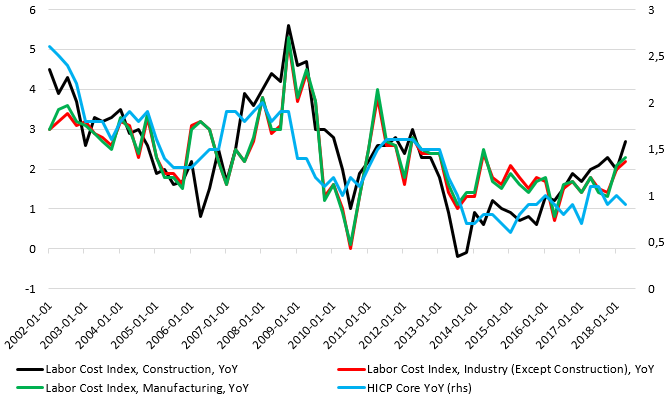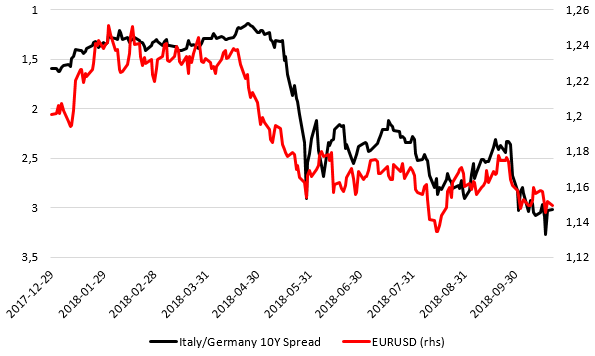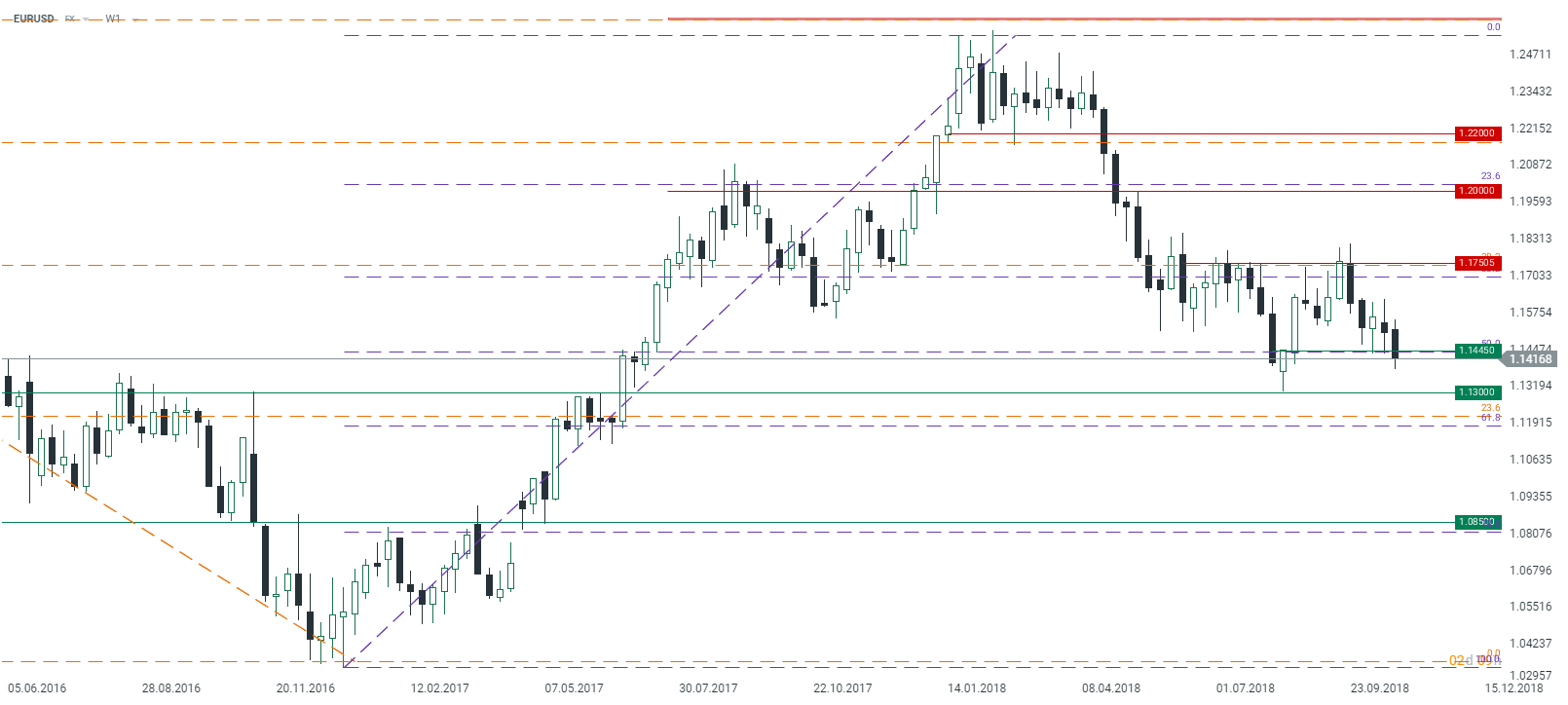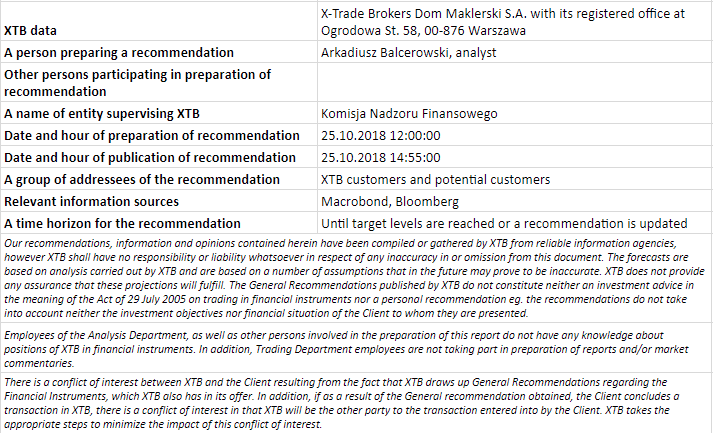Summary:
-
Concerns related to the Italian budget as well as weak PMIs from European economies constitute a major drag on the shared currency
-
Donald Trump promises subsequent tax cuts, a short-term boost but a long-term drag on the US dollar
-
US budget deficit is expected to widen significantly as opposed to Eurozone deficit
-
Eurozone current account surplus has widened noticeably, it has not been the case in the US
-
Eurozone labour costs have risen recently in pivotal branches of the economy
-
EURUSD dances around its crucial support line
Monetary policy in the United States and the Eurozone continues diverging. In theory, the higher rate differential between two countries, the more visible difference in currencies valuation. However, in this case the problem for the US dollar is that the current course in monetary policy has been more or less priced in, hence the dollar is unlikely to benefit substantially unless the Fed switches to a higher pace of rate increases. At the same time, the US dollar could be burdened with a so-called twin deficit. In turn, on the inflation front, some encouraging signs for the shared currency have arisen lately. What to expect on the EURUSD in the medium-term? In this analysis we outline our view touching on three major topics: fiscal policy in the US, labour costs in the Eurozone and an impact of Italy’s budget-related issues on the euro.
Comece a investir hoje ou teste gratuitamente uma conta demo
Abrir Conta TESTAR A DEMO Download mobile app Download mobile app
The more expansionary fiscal policy in the US as well as the widening differential in a current account balance compared to the Eurozone are the long-term drags on the dollar. Source: Macrobond, Bloomberg, XTB Research
The twin deficit - budget and current account - in the United States is singled out among fundamental reasons why the US dollar is unlikely to hold its current gains in the medium-term. Although this is nothing new for the US as it has been running such the deficit for more than a decade, this time seems to be different due to expansionary policy there at the time of the booming economy. After implementing tax cuts at the end of the past year, Donald Trump promises more tax reductions for a middle class as it seeks support for Republicans in the midterm elections taking place in the first week of November. In this context one may expect that loose fiscal policy is going to continue once Republicans hold a majority in the House and Senate. If this scenario materializes the US budget deficit is unlikely to shrink being a long-term drag on the US dollar. While the more expansionary fiscal policy could be the dollar negative in the long-term, it might not be the case in the short-term. This is due to the fact that lower taxes translate into higher disposable income and then (possibly) higher consumption expenditure. However, the so-called wealth effect also needs to be taken into our consideration. The longer the US stock market continues declining, the higher conviction among US inhabitants that their wealth is shrinking. Under these circumstances one may imagine that additional income coming from tax cuts would be saved rather than spent. Going back to the major topic one needs to notice that a difference between current accounts of the US and the Eurozone has recently widened to the highest since 2007 (ca. 6 percentage points). It means that the US has become more dependent on foreign capital (more debt) relatively to the Eurozone. This is undoubtedly the factor which could constrain further declines on the EURUSD.
 Labour costs in the Eurozone have shown an increase in the second quarter of 2018 despite adverse base effects. Source: Macrobond, XTB Research
Labour costs in the Eurozone have shown an increase in the second quarter of 2018 despite adverse base effects. Source: Macrobond, XTB Research
Wage growth has become the most prominent point in each employment report in the United States in recent months. This is also the case in the Eurozone albeit the European data in this field is published only once a quarter therefore market participants could lag in assessing these developments and putting them into their investment prospects. Let’s conclude that the Federal Reserve is unlikely to begin lifting interest rates at a higher pace that this presented in the most recent dot-plot. The impact from tax cuts (those implemented in December 2017) will disappear next year placing the US economy at a path of a slower growth. Having assumed the US central bank is right about the pace of price growth in the coming quarters it should stick to its path of rate rises with even a downside risk to this outlook. Let’s remind that the following year will be the last one with relatively ‘certain’ interest rate increases whereas the one hike anticipated in 2020 could be at risk should the economy start stuttering.
Looking at monetary policy conducted by the European Central Bank the one thing seems to be clear - the end of the bond buying programme in December is a done deal. Having said that, the outlook for rate increases remains still clouded (any rate rises are unlikely until September 2019) and is heavily dependent on domestic-driven price developments. On this front something has evolved of late which could be seen as the early signal of higher core inflation. We mean the labour costs (nominal) index climbing 2.2%YoY in the three months through June, the quickest pace of growth since mid-2011. Moreover, this rise was widespread and was seen in major branches of the economy. The more detailed analysis indicated that three branches of the economy have the highest correlation coefficients with core inflation measured as core HICP (excluding energy, food, alcohol and tobacco) - construction, manufacturing and industry (except construction). The correlation coefficients are as follows: 0.54, 0.40 and 0.39 respectively (the data taken from 2002). As we noted, the pick-up took place despite unfavourable base effects and these effects will be supportive of a higher pace of labour costs growth in the two remaining quarters this year. Therefore, one could quite easily imagine the yearly pace of growth exceeding the peak in the second quarter 2011 of 2.5%. In an environment of sluggish productivity growth in the Eurozone (growth hovers below 1% YoY since 2014), the ECB could be forced to lift rates to dampen higher inflation weighing on firms’ profitability.
 Performance of the shared currency is strongly tied to developments in Italy as evidenced by the chart above. Source: Bloomberg, XTB Research
Performance of the shared currency is strongly tied to developments in Italy as evidenced by the chart above. Source: Bloomberg, XTB Research
The last part of this analysis focuses on risks to the common currency. In this regard we need to pay attention to Italian woes related to a battle with the European Commission on a budget as well as the faltering manufacturing sector in Europe reflected by constantly declining PMIs. However, analyzing the two recent readings of German manufacturing PMI (September and October) one needs to be aware that they could have been affected by new and more strict carbon dioxide emissions standards. The Italy’s budget draft was rejected on Tuesday and the European Commission asked to submit a new one within three weeks. If Italy fails to do so, it will lead to disciplinary action from the European body. Based on our model the relationship between the EURUSD and the Italy/Germany 10Y spread has seen 81% correlation (the daily data since the beginning of this year). This analysis implies that the current level of the EURUSD (ca. 1.14) seems to be correct but the pair could witness a deeper pullback once the spread widens. Note that the Italy’s economy minister pledged earlier this month to do whatever is needed if the above-mentioned spread widens to 400 or 500 basis points. Such extreme moves would push the EURUSD to the levels ranging from 1.09 to 1.05 - based solely on the model we produced. However, some pundits claim that the pain threshold is closer to 350-360 basis points which would correspond to the EURUSD trading between 1.113 and 1.118. Nevertheless if Italy resubmits a revamped budget draft timely such the cheap euro seems to be unlikely. Finally, let us refer to the ongoing pullback/long-term trend change in the US stock market. If this move keeps unfolding it could ultimately translate into lower yields and thereby a higher Germany/US 10Y spread (yields in the US should fall more than these in Germany). If so, it could be supportive of our long recommendation.
At the press conference Mario Draghi admitted that the latest data was weaker than expected but he also added that it was consistent with the baseline scenario. Additionally, he reiterated that risks to economic growth are still ‘broadly balanced’ suggesting that the tight labour market and rising wage growth could push underlying inflation higher toward the end of the year. These remarks are in line with our call presented here.
 Having all the above-mentioned in mind we recommend to go long on the EURUSD at a market price with the target at 1.16 followed by 1.20 and the stop order paced at 1.1230. Source: xStation5
Having all the above-mentioned in mind we recommend to go long on the EURUSD at a market price with the target at 1.16 followed by 1.20 and the stop order paced at 1.1230. Source: xStation5

Este material é uma comunicação de marketing na aceção do artigo 24.º, n.º 3, da Diretiva 2014/65 / UE do Parlamento Europeu e do Conselho, de 15 de maio de 2014, sobre os mercados de instrumentos financeiros e que altera a Diretiva 2002/92 / CE e Diretiva 2011/61/ UE (MiFID II). A comunicação de marketing não é uma recomendação de investimento ou informação que recomenda ou sugere uma estratégia de investimento na aceção do Regulamento (UE) n.º 596/2014 do Parlamento Europeu e do Conselho de 16 de abril de 2014 sobre o abuso de mercado (regulamentação do abuso de mercado) e revogação da Diretiva 2003/6 / CE do Parlamento Europeu e do Conselho e das Diretivas da Comissão 2003/124 / CE, 2003/125 / CE e 2004/72 / CE e do Regulamento Delegado da Comissão (UE ) 2016/958 de 9 de março de 2016 que completa o Regulamento (UE) n.º 596/2014 do Parlamento Europeu e do Conselho no que diz respeito às normas técnicas regulamentares para as disposições técnicas para a apresentação objetiva de recomendações de investimento, ou outras informações, recomendação ou sugestão de uma estratégia de investimento e para a divulgação de interesses particulares ou indicações de conflitos de interesse ou qualquer outro conselho, incluindo na área de consultoria de investimento, nos termos do Código dos Valores Mobiliários, aprovado pelo Decreto-Lei n.º 486/99, de 13 de Novembro. A comunicação de marketing é elaborada com a máxima diligência, objetividade, apresenta os factos do conhecimento do autor na data da preparação e é desprovida de quaisquer elementos de avaliação. A comunicação de marketing é elaborada sem considerar as necessidades do cliente, a sua situação financeira individual e não apresenta qualquer estratégia de investimento de forma alguma. A comunicação de marketing não constitui uma oferta ou oferta de venda, subscrição, convite de compra, publicidade ou promoção de qualquer instrumento financeiro. A XTB, S.A. - Sucursal em Portugal não se responsabiliza por quaisquer ações ou omissões do cliente, em particular pela aquisição ou alienação de instrumentos financeiros. A XTB não aceitará a responsabilidade por qualquer perda ou dano, incluindo, sem limitação, qualquer perda que possa surgir direta ou indiretamente realizada com base nas informações contidas na presente comunicação comercial. Caso o comunicado de marketing contenha informações sobre quaisquer resultados relativos aos instrumentos financeiros nela indicados, estes não constituem qualquer garantia ou previsão de resultados futuros. O desempenho passado não é necessariamente indicativo de resultados futuros, e qualquer pessoa que atue com base nesta informação fá-lo inteiramente por sua conta e risco.
